Apple iPad Pro vs MacBook Air: Which should you buy?
Both have the same performance, but different everything else.
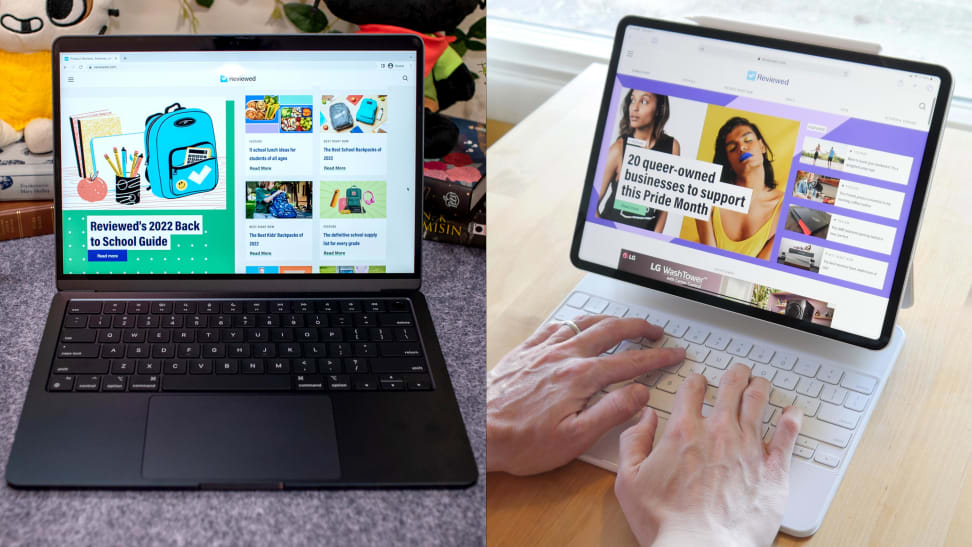 Credit:
Reviewed / Adrien Ramirez / Matthew S. Smith
Credit:
Reviewed / Adrien Ramirez / Matthew S. Smith
Recommendations are independently chosen by Reviewed's editors. Purchases made through the links below may earn us and our publishing partners a commission. Prices were accurate at the time this article was published but may change over time.
Apple’s iPad Pro M2 and MacBook Air 13 M2 (the MacBook Air 15 M2, too) share some of the same specifications: Apple’s impressive M2 chip, up to 16GB of RAM, and 2TB of storage space, so you'll get roughly the same performance out of both devices. Both are also lightweight, portable, and priced very similarly.
But that’s where the similarities end: After all, one is a tablet and the other is a laptop. They run on different operating systems, have different cameras, screen resolutions, cellular connectivity—the list goes on. Both the iPad Pro and MacBook Air are excellent productivity companions, but if you need a new device for more than checking emails, one will suit your needs better than the other.
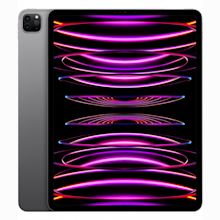
For those who like the size and versatility of tablets.
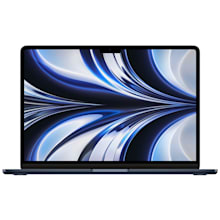
For those who need a no-fuss traditional laptop.
Form factor and configuration
If you want the iPad Pro to double as a laptop, you’ll need to buy a keyboard. Companies like Logitech make a wide array of iPad keyboards, and Apple has its own Magic Keyboard, of course. But depending on the brand you could find yourself spending anywhere between $20 to upwards of $300 for an iPad keyboard.
The 11-inch iPad Pro's base model comes with 8GB RAM, 128GB of storage, and no cellular connectivity for $799. If you add Apple’s Magic Keyboard ($299), the total comes to $1,098, or the same cost of a 13-inch MacBook Air. However, you could get the Smart Keyboard Folio for $179 and save a total of $221 by comparison.
The 12.9-inch version starts at $1,099. You’ll get a better display with this screen size, but you get nothing in the way of more storage. Doubling the SSD storage from 128GB to 256GB adds another $100 regardless of whether you opt for the 11-inch or 12.9-inch model—and the starting price ensures you will spend the same amount on this iPad Pro as a MacBook Air 13 M2 without a keyboard.
The MacBook Air M2 has four configurations. The first 13-inch model starts at $1,099 with an 8-core CPU and 8-core GPU, 8GB RAM, and 256GB SSD storage. The second has a 10-core GPU and double the storage for $1,399.
Both 15-inch models come with an 8/10-core M2 chip, and 8GB of memory (configurable to 64GB), but the lower-end configuration starts with a 256GB SSD for $1,299. The $1,499 model starts with 512GB of storage. Both are configurable up to 2TB.
There are a lot of ways to configure both devices, but the MacBook Air removes the headache of finding a reasonably-priced keyboard, and you get more for your money when it comes to storage.
Our pick: MacBook Air
Software compatibility

After the form factor, the major difference between the iPad Pro and MacBook Air is the operating system. The iPad Pro runs on iPadOS and the MacBook Air runs on macOS. The latter is a full-fledged operating system, while the former has more in common with the iPhone.
But things get confusing from here. Macs can run iPadOS apps, but iPads can’t run some macOS apps.
Final Cut Pro isn’t available on iPadOS. Logic Pro? That doesn’t exist on the iPad, but a simpler version, Logic Remote, does. Garage Band is available on both platforms, but the iPadOS version is a pared-down version with less nuanced controls and capabilities. Same with iMovie.
This sort of cross-platform availability largely depends on where developers decide to make their apps available. But for Apple-made programs like the ones mentioned above, it’s a mystery as to why the same version (or a version at all) doesn’t exist on iPadOS even though the iPad Pro has the same processing power as the MacBook Air.
This goes without saying if you need the full version of any of the above programs, the iPad Pro is not the best choice for that.
Our pick: MacBook Air
Connectivity
Both the iPad Pro and MacBook Air don’t have many physical ports, but the MacBook Air wins over the iPad Pro because it has more by comparison. While the iPad Pro only has one USB Thunderbolt 4 port, the MacBook Air has two USB Thunderbolt 4 ports, plus a 3.5mm audio jack.
This means you can charge your laptop and plug in another device, like a flash drive, at the same time. If you wanted to do the same with the iPad Pro you’d need to buy a separate Thunderbolt dock.
However, the MacBook Air does not have a Cellular connectivity option. Both devices have Wi-Fi 6 and Bluetooth 5.0, but the iPad Pro is the only one you can take with you to the park and play Doom in the cloud over a 4G or 5G connection. Or maybe you take the train to work and you need reliable access to the internet. The iPad Pro has you covered there, too.
But if you want the cheapest option possible, then you’re stuck with an 11-inch display with a less powerful OS for the same price as a 13-inch MacBook Air M2.
Our pick: Tie
Display
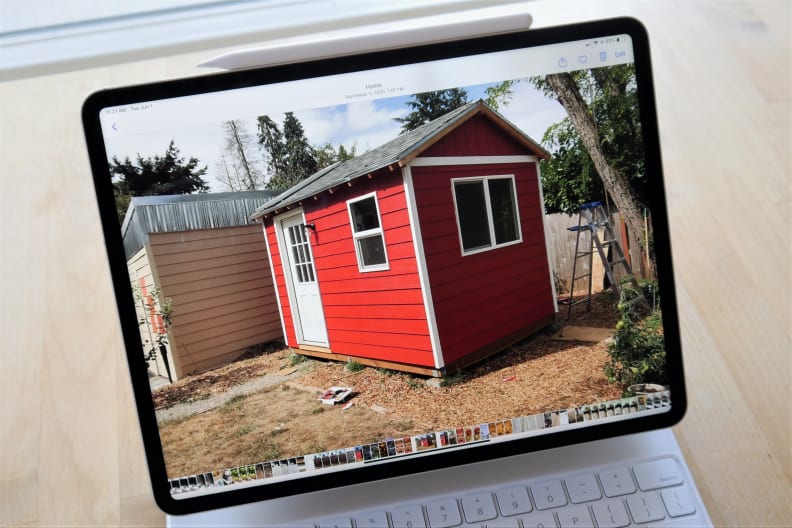
This is the one category where the iPad Pro wins outright, but let’s start with the MacBook Air.
Compared to the iPad Pro, the MacBook Air’s display isn’t all that fancy. The Retina LED-backlit display supports up to a 2560 x 1664 resolution with a max 500 nits brightness. Like both iPad Pro models, its display has a wide color gamut (P3) and True Tone technology, but that’s where the similarities end.
Both iPad Pro models have True Tone displays with a wide color gamut (P3) and 600 nits max brightness (non-HDR content). But the 12.9-inch model has a fancier display that supports up to 1000 nits max full-screen brightness and 1600 nits peak brightness for HDR content. The 11-inch model has a max resolution of 2388 x 1668, and the 12-inch model’s max resolution is 2732 x 2048.
Both models also have a mini-LED backlit display. The 12.9-inch iPad Pro also has a 2D backlighting system with 2596 full-array local dimming zones, so contrast and colors really pop.
And, of course, the iPad Pro displays are touch displays, with support for Apple Pencil Hover, but the MacBook Air doesn’t have one. (I mean you can touch it, but nothing will happen.)
Our pick: iPad Pro
Battery life
The MacBook Air can get up to 15 hours of battery life, while the iPad Pro can only get up to ten hours. (The cellular models get up to nine hours.) If you were considering getting the iPad Pro as a laptop replacement but were concerned about the battery life, you get more for your money with the MacBook Air.
Our pick: MacBook Air
And the winner is…
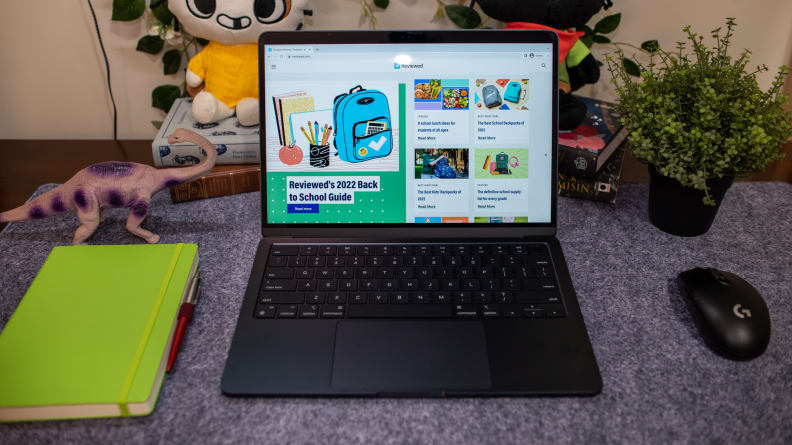
When it comes to which device can be the best laptop, it’s no surprise Apple’s MacBook Air is the best because it’s, well, a laptop. Along with better battery life, more ports, and a more robust OS, the MacBook Air boasts a better value than the iPad Pro; it already has everything you could possibly need.
The iPad Pro serves a narrower demographic. But if you absolutely must have a touch-screen device, the iPad Pro is still a great, reliable machine. Just keep in mind that you could end up paying more for it than a MacBook Air.

For those who like the size and versatility of tablets.

For those who need a no-fuss traditional laptop.





